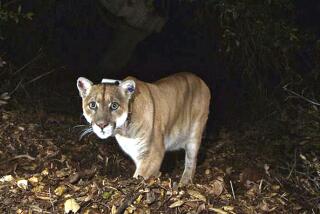Walk on the Wildness Side
- Share via
Alaska’s vast Denali National Park is divided into designated tracts of wilderness, some as big as whole counties. Snowfields and glaciers on the northern face of the Alaska Range mountains feed wide-braided rivers that cut valleys through tundra. The landscape is treeless and trail-less as far as you can see, and far beyond. There are no markers or signposts to designate where one tract ends and another begins. They appear only on maps for the purpose of allotting back-country hiking permits.
The park service is trying, with these area designations and permits, to preserve an authentic wilderness experience for those willing to work, and wait, for it. When you finally head out across the spongy tundra, you know that you will not end up camped across a river valley from other humans. For a short while, you will have a swath of original America to yourself.
Of these 44 wilderness tracts, a portion of one is even more special. It’s off-limits. It’s called Sable Pass, 60 or so square miles of lumpy tundra protected against human intrusion, except for scientists who have carved themselves an exemption. The purpose is to give wildlife one true sanctuary from people.
Sable Pass is in my thoughts because the last of the nation’s public lands are in political play these days, and too often we limit the discussion to how these lands should be “used.” Backpackers versus Jeeps. Oil drilling versus caribou. Tree cutters versus tree huggers. Jobs versus recreation.
Snow-mobilers want wide-open winter access into the heart of Denali and other Western parks. Oil companies are being encouraged to drill deeper into the Arctic. Road builders are itching to get into the last of the national forests to cut trees, fight fires, explore for resources and expand the playground for hunters and four-wheelers. We are told that “balance” can be achieved between competing uses if we’ll just be sensible and compromise.
Some of my most soaring memories are of hiking in the wildlands of Denali Park on the edges of Sable Pass, never entering but always wondering.
One afternoon, a hungry grizzly bear walked into camp. Hair stands up on my neck when I recall looking into the unblinking, chestnut-colored eyes of that bear, 10 feet away, his nose rotating like a radar dish. My three companions and I had no choice but to huddle to the side while he sniffed and pawed our camping gear and decided whether to absorb us into the food chain.
We named him “Junior” after he wandered off. He still stalks my dreams. I awaken at night to the smell of him, and say my thanks. I have hiked among more than 50 other grizzly bears in my life, but this one turned the moment into an encounter. He enriched our lives by the freedom and power of his. I hope he is doing well up there.
There is another memory that arises from those glorious, mosquito-bitten, back-aching trips. It has grown larger in my mind’s eye than even Junior has.
It’s the idea of forbidden territory. Sacred ground. Land of mystery. An untouched place. Don’t go there. Sable Pass.
I once proposed writing a story about Sable Pass. A travel editor rejected the idea outright. She said people wouldn’t care about a place they could not go to.
I think she was wrong.
Through most of our human history, we have cherished the idea of unknown places. Native American mythology speaks of spirit lands. Until recently, mountain cultures in the Himalayas forbade trespassing into sacred valleys. The most wondrous maps ever made are those ancient ones that show known terrain, and beyond just blankness and the words: “There be dragons.”
From the edge of Sable Pass, you can peer into the one place where there might actually be a dragon. At least, we cannot enter to prove otherwise.
Only 6 by 10 miles, that tundra redoubt is a reminder that wilderness has value beyond direct human use or wildlife preservation.
It is a place to set our imaginations free.
Wilderness is wildness. And wildness, true wildness in the big sense of the word, is America’s most threatened commodity.
As Athabascan natives say, wildness is a place for the mind to walk. Wildness is our heritage. It is the landscape of our progenitors. It is our ancestral home. Like art and music, wildness is an essential detail that defines both beauty and humility in our lives, in all life. Wildness is a check against the belief that technology and progress can defy the logic, and the laws, of nature. Wildness, like the grizzly bear, restrains our egos, reminding us that we are part of the living, breathing web of life, nourished by other life. Depending on your belief, wildness was what God gave us, or perhaps what gave us God.
I would feel better about the future if our political debate about public lands accounted for the intangible, but vital, need for wildness. Not just for nature’s sake but for the sake of our souls. Can elk live on pastures with cows? Yes. Can caribou co-exist with oil rigs? They do. Grizzly bears can live in garbage dumps too.
But wildness, true wildness, does not exist with cow pastures and oil rigs and garbage dumps. Wildness is not defined by how it can be used. Like Sable Pass, wildness is about not using it at all. Except to preserve our diminishing sense of wonder.
More to Read
Sign up for The Wild
We’ll help you find the best places to hike, bike and run, as well as the perfect silent spots for meditation and yoga.
You may occasionally receive promotional content from the Los Angeles Times.






